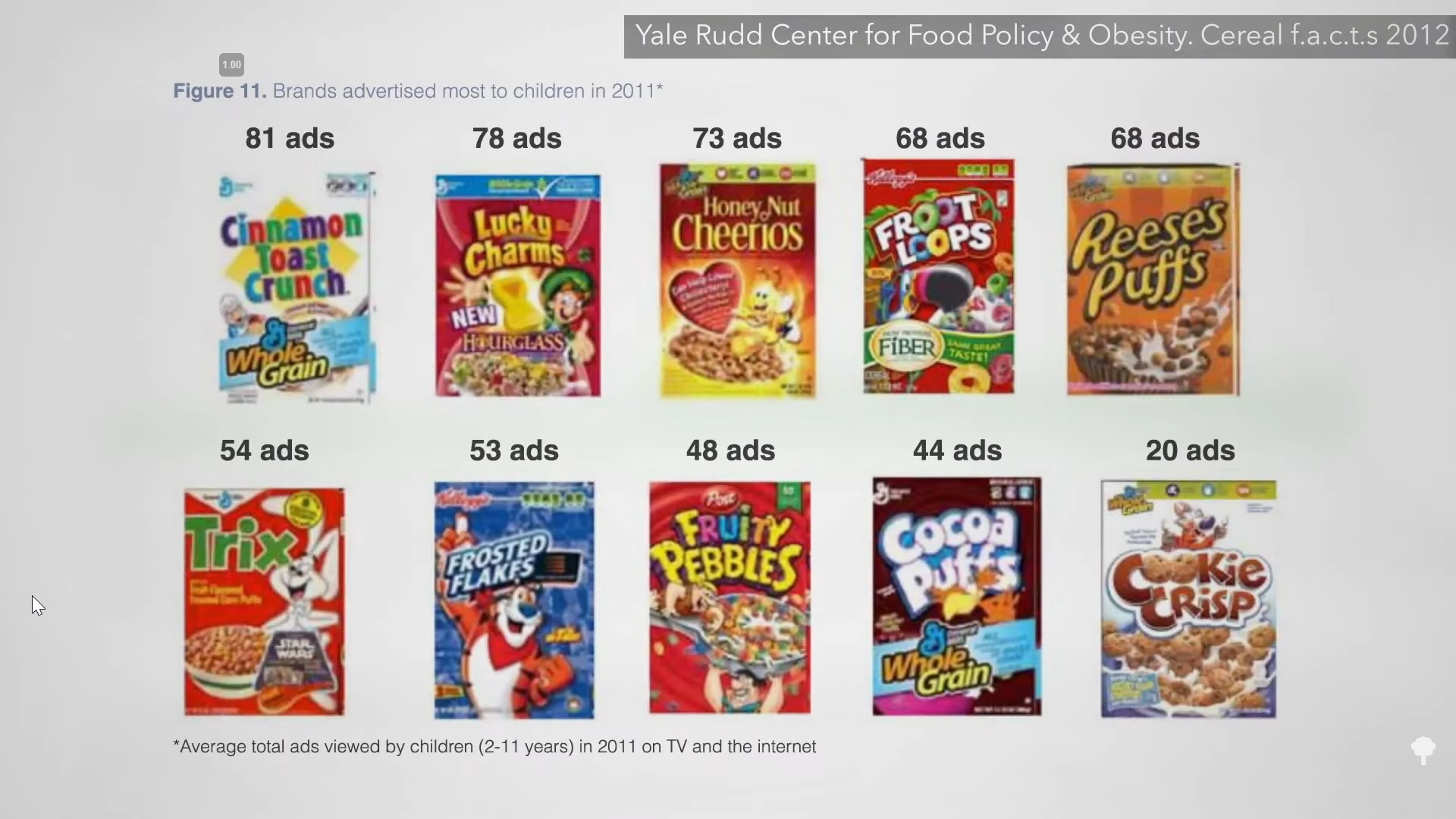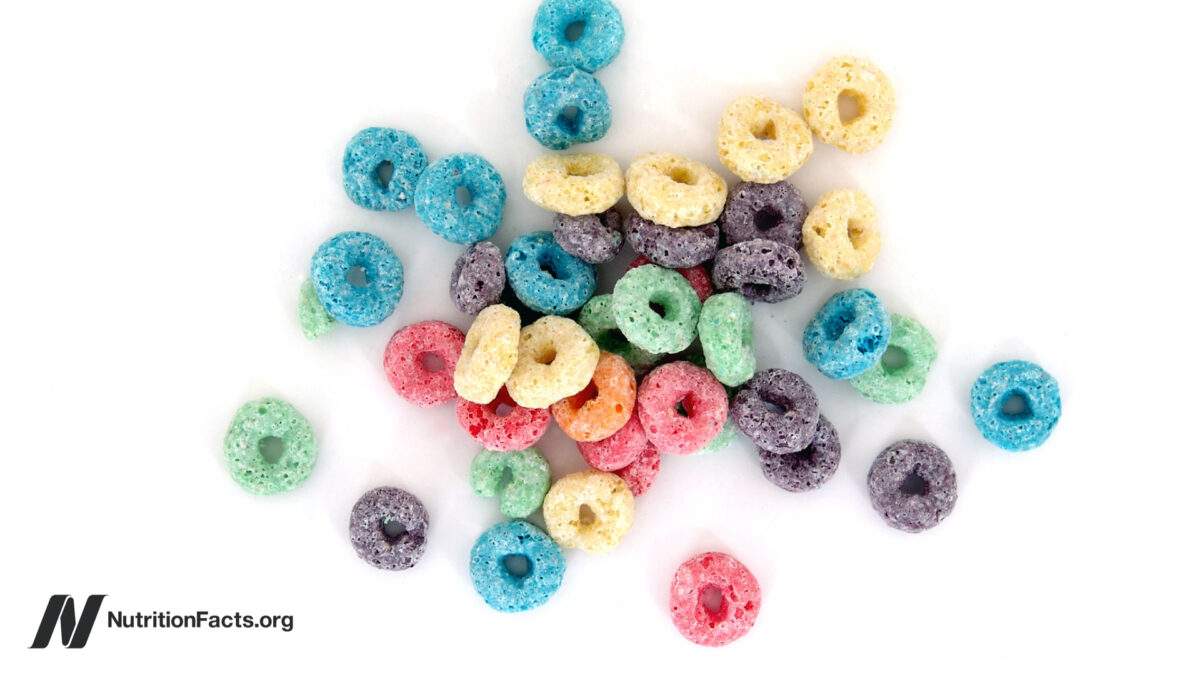What can millions of dollars in the hands of the lobbying industry do to shut down efforts to protect children?
For nearly half a century, there have been calls to ban the advertising of sugary cereals to children, a product that Harvard nutrition professor Jean Mayer referred to as “sugar-coated nothings.” In a Senate hearing on nutrition education, he said, “Properly speaking, they ought to be called cereal-flavored candy, rather than sugar-covered cereals.”
As I discuss in my video A Political Lesson on the Power of the Food Industry, the Senate committee invited the major manufacturers of children’s cereals to testify, and they initially said yes—until they heard what kinds of questions were going to be asked. One cereal industry representative candidly admitted why the decision was made to boycott the hearing: They simply didn’t have “persuasive answers” to why they were trying to sell kids breakfast candy.
In the Mad Men age before the consumer movement was in bloom, ad “company executives were more willing to talk frankly about the purpose of their ads and how they felt about aiming the ads at the ‘child market.’” Said an executive of the Kellogg’s ad firm: “Our primary goal is to sell products to children, not educate them. When you sell a woman on a product and she goes into the store and finds your brand isn’t in stock, she’ll probably forget about it. But when you sell a kid on your product, if he can’t get it, he will throw himself on the floor, stamp his feet and cry. You can’t get a reaction like that out of an adult.”
Sugary cereals are the number one food advertised to kids, but don’t worry—the industry will just self-regulate. “In response to public health concerns about the amount of marketing for nutritionally poor food directed to children, the Council of Better Business Bureaus launched the Children’s Food and Beverage Advertising Initiative” in which all the big cereal companies “pledged to market only healthier dietary choices in child-directed advertising.” The candy industry signed on, too. Despite pledging not to advertise to kids, after the initiative went into effect, kids actually saw more candy ads. Take Hershey, for example. It doubled its advertising to children “at the same time it pledged to not advertise to children.”
The cereal companies got to decide for themselves their own definitions of “healthier dietary choices.” That should give us a sense of how serious they are at protecting children. For example, they classified “Froot Loops and Reese’s Peanut Butter Puffs consisting of up to 44% sugar by weight…as ‘healthier dietary choices.’” In that case, what are their unhealthy choices? It seems that the Children’s Food and Beverage Advertising Initiative basically just “based its maximal nutrient levels more on the current products marketed by its members than on a judgment about what was best for children.”
Now, they’ve since revised that to allow only cereals that are 38 percent sugar by weight. But even if they are only one-third sugar, that means kids are effectively eating “one spoonful of sugar in every three spoons of cereal”—not exactly a healthier dietary choice.
The Federal Trade Commission tried stepping in back in 1978, but the industry poured in so many millions of dollars in lobbying might that Congress basically threatened to yank the entire agency’s funding should the FTC mess with Big Cereal, demonstrating just “how powerful market forces are compared to those that can be mobilized on behalf of children.” The political “post-traumatic stress induced by the aggressive attacks on the FTC led to a twenty-five-year hiatus in federal efforts to rein in food marketing aimed at children.”
Finally, enter the Interagency Working Group with members from four federal agencies—the FTC, CDC, FDA, and USDA. The group developed a set of “voluntary principles [that] are designed to encourage stronger and more meaningful self-regulation by the food industry and to support parents’ efforts to get their kids to eat healthier foods.” It proposed the radical suggestion of not marketing to children cereals that are more than 26 percent pure sugar.
As you can see below and at 4:02 in my video, the top ten breakfast cereals marketed to children are Cinnamon Toast Crunch, Lucky Charms, Honey Nut Cheerios, Froot Loops, Reese’s Puffs, Trix, Frosted Flakes, Fruity Pebbles, Cocoa Puffs, and Cookie Crisp—and not a single one would meet that standard. General Mills shot back: “The Proposal’s nutrition standards are arbitrary, capricious, and fundamentally flawed.” No surprise since “literally all cereals marketed by General Mills would be barred from advertising”—not a single one would make the cut. To suggest voluntary standards “unconstitutionally restrains commercial speech in violation of the First Amendment,” to which the FTC basically replied: Let me get you a dictionary. How could suggesting voluntary guidelines violate the Constitution? But that’s how freaked out the industry is at even the notion of meaningful guidelines. One grocer’s association actually called the proposed nutrition principles the “most bizarre and unconscionable” it had ever seen.

So, what happened? Again, agency funding was jeopardized, so the FTC called off the interagency proposal.
“At every level of government, the food and beverage industries won fight after fight….They have never lost a significant political battle in the United States…” Said a director of one of the child advocacy organizations: “We just got beat. Money wins.” And it took a lot of money—$175 million of Big Food lobbying funds. It was apparently enough to buy the White House’s silence as the interagency proposal got killed off. As one Obama advisor put it, “You can tell someone to eat less fat, consume more fiber, more fruits and vegetables, and less sugar. But if you start naming foods, you cross the line.”
“‘I’m upset with the White House,’ said Senator Tom Harkin (D-Iowa), chairman of the Senate Health Committee. ‘They went wobbly in the knees, and when it comes to kids’ health, they shouldn’t go wobbly in the knees.’”
For more on breakfast cereals, click here. And click here for more on sugar.
I am all in favor of Taking Personal Responsibility for Your Health, but the strong-arm tobacco-style tactics of the multitrillion-dollar food industry are contributing to the deaths of an estimated 14 million people every year.
On a brighter note, check out How We Won the Fight to Ban Trans Fat.
For more on sugar specifically, see Flashback Friday: Sugar Industry Attempts to Manipulate the Science.
Check out my other videos on breakfast cereals: Flashback Friday: The Worst Food for Tooth Decay and How to Stop Tooth Decay. Are there any healthy cereals? A few make the cut. See Flashback Friday: The Five-to-One Fiber Rule.
